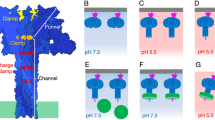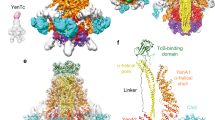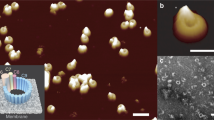Abstract
We analyzed the 440-kDa transmembrane pore formed by the protective antigen (PA) moiety of anthrax toxin in the presence of GroEL by negative-stain electron microscopy. GroEL binds both the heptameric PA prepore and the PA pore. The latter interaction retards aggregation of the pore, prolonging its insertion-competent state. Two populations of unaggregated pores were visible: GroEL-bound pores and unbound pores. This allowed two virtually identical structures to be reconstructed, at 25-Å and 28-Å resolution, respectively. The structures were mushroom-shaped objects with a 125-Å-diameter cap and a 100-Å-long stem, consistent with earlier biochemical data. Thus, GroEL provides a platform for obtaining initial glimpses of a membrane protein structure in the absence of lipids or detergents and can function as a scaffold for higher-resolution structural analysis of the PA pore.
This is a preview of subscription content, access via your institution
Access options
Subscribe to this journal
Receive 12 print issues and online access
$189.00 per year
only $15.75 per issue
Buy this article
- Purchase on Springer Link
- Instant access to full article PDF
Prices may be subject to local taxes which are calculated during checkout





Similar content being viewed by others
References
Young, J.A. & Collier, R.J. Anthrax toxin: receptor binding, internalization, pore formation, and translocation. Annu. Rev. Biochem. 76, 243–265 (2007).
Krantz, B.A., Finkelstein, A. & Collier, R.J. Protein translocation through the anthrax toxin transmembrane pore is driven by a proton gradient. J. Mol. Biol. 355, 968–979 (2006).
Deaton, J. et al. Functional bacteriorhodopsin is efficiently solubilized and delivered to membranes by the chaperonin GroEL. Proc. Natl. Acad. Sci. USA 101, 2281–2286 (2004).
Sun, J. et al. Asymmetric binding of membrane proteins to GroEL. Arch. Biochem. Biophys. 434, 352–357 (2005).
Benson, E.L., Huynh, P.D., Finkelstein, A. & Collier, R.J. Identification of residues lining the anthrax protective antigen channel. Biochemistry 37, 3941–3948 (1998).
Nassi, S., Collier, R.J. & Finkelstein, A. PA63 channel of anthrax toxin: an extended beta-barrel. Biochemistry 41, 1445–1450 (2002).
Petosa, C., Collier, R.J., Klimpel, K.R., Leppla, S.H. & Liddington, R.C. Crystal structure of the anthrax toxin protective antigen. Nature 385, 833–838 (1997).
Lacy, D.B. et al. A model of anthrax toxin lethal factor bound to protective antigen. Proc. Natl. Acad. Sci. USA 102, 16409–16414 (2005).
Song, L. et al. Structure of staphylococcal alpha-hemolysin, a heptameric transmembrane pore. Science 274, 1859–1866 (1996).
Nguyen, T.L. Three-dimensional model of the pore form of anthrax protective antigen. Structure and biological implications. J. Biomol. Struct. Dyn. 22, 253–265 (2004).
Horovitz, A., Fridmann, Y., Kafri, G. & Yifrach, O. Review: allostery in chaperonins. J. Struct. Biol. 135, 104–114 (2001).
Lacy, D.B. et al. Structure of heptameric protective bound to an anthrax toxin receptor: a role for receptor in pH-dependent pore formation. Proc. Natl. Acad. Sci. USA 101, 13147–13151 (2004).
Rosovitz, M.J. et al. Alanine-scanning mutations in domain 4 of anthrax toxin protective antigen reveal residues important for binding to the cellular receptor and to a neutralizing monoclonal antibody. J. Biol. Chem. 278, 30936–30944 (2003).
Voziyan, P.A., Jadhav, L. & Fisher, M.T. Refolding a glutamine synthetase truncation mutant in vitro: identifying superior conditions using a combination of chaperonins and osmolytes. J. Pharm. Sci. 89, 1036–1045 (2000).
Voziyan, P.A., Johnston, M., Chao, A., Bomhoff, G. & Fisher, M.T. Designing a high throughput refolding array using a combination of the GroEL chaperonin and osmolytes. J. Struct. Funct. Genomics 6, 183–188 (2005).
Goulhen, F., Dé, E., Pagès, J.-M. & Bolla, J.-M. Functional refolding of the Campylobacter jejuni MOMP (major outer membrane protein) porin by GroEL from the same species. Biochem. J. 378, 851–856 (2004).
Krantz, B.A. et al. A phenylalanine clamp catalyzes protein translocation through the anthrax toxin pore. Science 309, 777–781 (2005).
Miller, C.J., Elliott, J.L. & Collier, R.J. Anthrax protective antigen: prepore-to-pore conversion. Biochemistry 38, 10432–10441 (1999).
Wigelsworth, D.J. et al. Binding stoichiometry and kinetics of the interaction of a human anthrax toxin receptor, CMG2, with protective antigen. J. Biol. Chem. 279, 23349–23356 (2004).
Zhang, S., Finkelstein, A. & Collier, R.J. Evidence that translocation of anthrax toxin's lethal factor is initiated by entry of its N terminus into the protective antigen channel. Proc. Natl. Acad. Sci. USA 101, 16756–16761 (2004).
Voziyan, P.A. & Fisher, M.T. GroE-mediated folding of glutamine synthetase under non-permissive conditions; off-pathway aggregation propensity does not determine the co-chaperonin requirement. Protein Sci. 9, 2405–2415 (2000).
Mueller, P. & Rudin, D.O. Induced excitability in reconstituted cell membrane structure. J. Theor. Biol. 4, 268–280 (1963).
Blaustein, R.O. & Finkelstein, A. Voltage-dependent block of anthrax toxin channels in planar phospholipid bilayer membranes by symmetric tetraalkylammonium ions. J. Gen. Physiol. 96, 905–919 (1990).
Frank, J. et al. SPIDER and WEB: processing and visualization of images in 3D electron microscopy and other fields. J. Struct. Biol. 116, 190–199 (1996).
Huang, C.C., Couch, G.S., Pettersen, E.F. & Ferrin, T.E. Chimera: an extensible molecular modeling application constructed using standard components. Pac. Symp. Biocomput. 724 (1996).
Acknowledgements
M.T.F. dedicates this work to the memory of Earl R. Stadtman, his mentor during his postdoctoral years at the US National Institutes of Health (NIH). Earl's influence, scientific philosophy and sense of generosity will be with M.T.F. for the rest of his days. This research was supported in part by US National Science Foundation (NSF) grant MCB-0445936 (M.T.F.), NIH grant R41 GM080074 (M.T.F.), a grant from the Kansas Technology Enterprise Corporation (M.T.F.) and NIH grant 5R37AI022021 (R.J.C.). The NSF grant supported J.J. and M.B. GroEL was a gift from EdgeBiosystems.
Author information
Authors and Affiliations
Contributions
H.K. and B.E.J. contributed equally to the experimental design, the execution of the experiments and the interpretation of the data; they also contributed to the writing of the manuscript. Undergraduates J.J. and M.B. were involved in computer setup, network support, image scanning, data cataloging, some particle picking and initial alignment work under the guidance of H.K., S.F., E.P.G. and M.T.F. E.P.G, R.J.C. and M.T.F. contributed to experimental design, provided guidance, analysis and interpretation of the data and were responsible for writing the manuscript.
Corresponding author
Ethics declarations
Competing interests
R.J.C. holds equity in PharmAthene, Inc., and is a consultant for CombinatoRx, Inc.
Supplementary information
Supplementary Text and Figures
Supplementary Figures 1–6 and Supplementary Discussion (PDF 361 kb)
Rights and permissions
About this article
Cite this article
Katayama, H., Janowiak, B., Brzozowski, M. et al. GroEL as a molecular scaffold for structural analysis of the anthrax toxin pore. Nat Struct Mol Biol 15, 754–760 (2008). https://doi.org/10.1038/nsmb.1442
Received:
Accepted:
Published:
Issue Date:
DOI: https://doi.org/10.1038/nsmb.1442
This article is cited by
-
Folding of newly translated membrane protein CCR5 is assisted by the chaperonin GroEL-GroES
Scientific Reports (2015)
-
Following Natures Lead: On the Construction of Membrane-Inserted Toxins in Lipid Bilayer Nanodiscs
The Journal of Membrane Biology (2015)
-
Recombinant GroEL enhances protective antigen-mediated protection against Bacillus anthracis spore challenge
Medical Microbiology and Immunology (2013)
-
Supercharging Protein Complexes from Aqueous Solution Disrupts their Native Conformations
Journal of the American Society for Mass Spectrometry (2012)
-
Structural basis for the unfolding of anthrax lethal factor by protective antigen oligomers
Nature Structural & Molecular Biology (2010)



